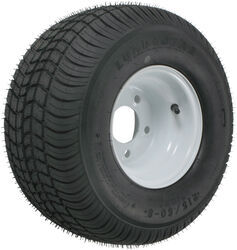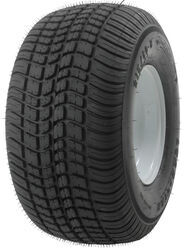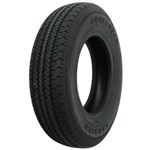
Difference Between Bias Ply And Radial Ply Trailer Tires And What Does Load Range Mean
Question:
What is the different between Bias ply vs Radial tires? and What is the load B,C,D mean? how do you know the weight in pounds capacity by using this load B,C,D capacity?
asked by: Jose
Expert Reply:
The main difference between bias ply and radial ply tire is how the tire is constructed. The cords underneath the tire are run in different directions. On a bias tire, the cords run at a 32 degree angle from the direction of travel and on a radial tire, the cords will run at 90 degrees from direction of travel, or across the tire from wheel lip to wheel lip.
Because of the construction of a radial tire, the tire has more flex and will allow for more ground contact. That will improve traction and better treadwear. It also gives the radial tire better stability.
A bias tire will have a stiffer sidewall and shoulder, which will increase heat buildup in the tire. The radial tire will run cooler which will help the tire last longer, especially when the tire is under a load. At one time the cost was a big difference, but now with the radial tires being close in price they are a much better value.
The B, C, and D is the load range of a tire. This is the maximum weight that the tire can carry at a specified maximum load inflation. The B is a 4-ply rated tire, the C is a 6-ply rated tire, and the D is a 8-ply rated tire.
The load range is stamped on each tire and right after the load range letter is the maximum weight at maximum psi for that tire. The load range weight capacity will also vary depending on the size of the tire. Trailer tires will always need to be inflated to the maximum psi that is specified on the tire.
The Trailer Tire and Wheel - 215/60-8 - 5 on 4-1/2 - Load Range C, part # AM3H310, has a maximum weight capacity of 935 lbs. at 50 psi.
The Kenda 215/60-8 Bias Trailer Tire with 8 Inch White Wheel - 5 on 4-1/2 - Load Range D, part # AM3H323, with a maximum weight capacity of 1,165 lbs. at 70 psi.
I am including a link to a FAQ page on tire information.

Products Referenced in This Question
Kenda 215/60-8 Bias Trailer Tire with 8" White Wheel - 5 on 4-1/2 - Load Range D
- Trailer Tires and Wheels
- Tire with Wheel
- Bias Ply Tire
- Load Range D
- 215/60-8
- 8 Inch
- M - 81 mph
- 5 on 4-1/2 Inch
- Steel Wheels - Powder Coat
- Kenda
more information >
Product Page this Question was Asked From
Kenda 215/60-8 Bias Trailer Tire with 8" White Wheel - 5 on 4-1/2 - Load Range C
- Trailer Tires and Wheels
- Tire with Wheel
- Bias Ply Tire
- Load Range C
- 215/60-8
- 8 Inch
- 5 on 4-1/2 Inch
- Steel Wheels - Powder Coat
- Kenda
more information >
Featured Help Information
Miscellaneous Media

Continue Researching
- Shop: Kenda 215/60-8 Bias Trailer Tire with 8" White Wheel - 5 on 4-1/2 - Load Range D
- Shop: Kenda 5.30-12 Bias Trailer Tire with 12" White Wheel - 5 on 4-1/2 - Load Range D
- Shop: Kenda 4.80-12 Bias Trailer Tire with 12" White Wheel - 4 on 4 - Load Range C
- Shop: Kenda Karrier S-Trail ST145/R12 Radial Tire w/ 12" White Spoke Wheel - 4 on 4 - LR D
- Shop: Offset Trailer Spare Tire Mount by Dutton-Lainson
- Shop: Kenda 215/60-8 Bias Trailer Tire with 8" White Wheel - 5 on 4-1/2 - Load Range C
- Shop: Roof Rack
- Q&A: Trailer Tire Recommendations for a Trailer Towed by a Motorcycle
- Q&A: Recommended Spare Tire Carrier For 8-Inch Wheel With 5 On 4-1/2 Bolt Pattern
- Search Results: spare carrier
- Search Results: fhdstc0101
- Shop: Kenda 5.70-8 Bias Trailer Tire with 8" White Wheel - 5 on 4-1/2 - Load Range C
- Shop: Spare Tire Cover
- Q&A: Determining Wheel Bearings and Bearing Buddies For Snow Bear Utility Trailer 6000
- Search Results: 5.30 12 trailer tire
- Shop: Trailer Wiring
- Video: Bulldog Inner Tube Square Tube Gooseneck CouplerSquare Tube Gooseneck Coupler Review
- Q&A: Wire Gauge Recommended for a 7-Way Trailer Connector
- Q&A: Difference Between Trailer Tires ST205/75D14 and ST205/75R14
- Q&A: What is the Wire Gauge Used in Curt 5th Wheel/Gooseneck Wiring for 2015 Ford F-250
- Search Results: pigtail wiring harness
- Search Results: 205 75 14 tire and wheel
- Search Results: gooseneck coupler square
- Search Results: dump trailer parts
- Shop: Tailgate
- Shop: Truck Bed Tailgate Assist
- Q&A: Where are Kenda Trailer Tires Made
- Video: Lionshead Trailer Wheel Center Cap Review
- Video: Americana Tires and Wheels AM90175 Review
- Video: Review of Kenda Trailer Tires and Wheels - Tire with Wheel - AM31952






